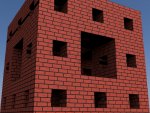help with brick texture node
Hi!
at last i've find some time to play with v5 node editor... i'd like to use the brick texture node with random width and depth and to (randomly) slide the brick lines (i guess i have to tweak the "position" value for that but i'd like a different value for each line)
although i (casually) find some nice fx tweaking nodes and parameters i'm far from a decent solution so any help/hint will be very appreciated
thank you in advance,
Alessandro
p.s.: please talk very slow 'cause i'm totally new about this (as you may have noticed:redface: )
Hi!
at last i've find some time to play with v5 node editor... i'd like to use the brick texture node with random width and depth and to (randomly) slide the brick lines (i guess i have to tweak the "position" value for that but i'd like a different value for each line)
although i (casually) find some nice fx tweaking nodes and parameters i'm far from a decent solution so any help/hint will be very appreciated
thank you in advance,
Alessandro
p.s.: please talk very slow 'cause i'm totally new about this (as you may have noticed:redface: )







